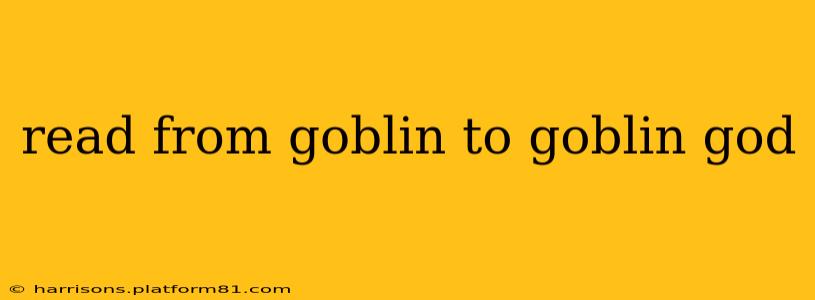From Goblin to Goblin God: A Journey Through Goblin Lore and Mythology
Goblins. The name conjures images of mischievous creatures, lurking in shadows, hoarding treasure, and generally causing mayhem. But the reality of goblins, particularly when exploring their lore and mythology across various cultures and fictional worlds, is far richer and more nuanced than simple caricature. This journey delves into the fascinating evolution of the goblin, from its humble beginnings as a minor folkloric figure to its complex portrayals in modern fantasy.
What are goblins and where did they originate?
The origins of the goblin are shrouded in mystery, tracing back to early European folklore. They weren't uniformly described; regional variations abounded. Some cultures depicted goblins as malevolent, others as mischievous sprites, and still others as somewhat helpful, albeit unpredictable, beings. Their appearances also varied greatly, ranging from small, grotesque creatures to larger, more humanoid figures. This lack of a single, definitive origin story is part of what makes them so fascinating to study. Their ambiguity allows for endless creative interpretation.
Are goblins evil? Are they always portrayed as evil?
The answer is a resounding "no." While many depictions of goblins emphasize their mischievous or even malicious nature—think of the greedy, treacherous goblins in The Hobbit—many other portrayals present them in a far more complex light. Some stories depict goblins with a strong sense of community and loyalty, albeit within the context of their often-unconventional moral codes. In some folklore, goblins can even be seen as protectors of nature or guardians of specific locations. The inherent ambiguity of their nature is key to their enduring appeal. Their morality is often situational, reflecting the environment and needs of the story.
What is the difference between goblins, hobgoblins, and kobolds?
This is a common point of confusion, as the terms are often used interchangeably, particularly in modern fantasy literature. However, traditional folklore does draw some distinctions. Hobgoblins are generally considered to be a larger, more powerful, and often more malevolent variant of goblins. Kobolds, on the other hand, are often depicted as less malicious and more associated with the home, sometimes even acting as household guardians—although their helpfulness can be unpredictable, and often comes with a price. These distinctions are not always consistently applied across different cultures or fictional works, however, leading to the fluidity of these terms in modern fantasy.
What are some examples of goblins in popular culture?
Goblins have had a significant impact on popular culture, appearing in countless books, films, video games, and other media. From the classic depiction of Tolkien's goblins to the more nuanced portrayals in games like World of Warcraft, the goblin has remained a staple of fantasy. Their adaptability—their ability to be both comical and terrifying, cunning and crude—makes them endlessly fascinating characters. Their consistent presence in popular culture speaks volumes about the enduring power of this enigmatic creature.
Can goblins become gods? How are goblin gods represented?
The idea of a "Goblin God" is a fascinating concept that often appears in modern fantasy settings. While traditional folklore rarely elevates goblins to such a status, modern writers and game developers have explored the idea of goblin pantheons and deities. These goblin gods often reflect the traits typically associated with goblins: cunning, greed, trickery, and a chaotic, unpredictable nature. Their worship is often characterized by fervent, if slightly disorganized, rituals and a devotion to survival and self-preservation above all else. The concept of a goblin god showcases the adaptability of the goblin archetype and its potential for complex theological interpretations.
This exploration of goblin lore only scratches the surface of this multifaceted creature. The enduring appeal of the goblin lies in its ambiguity, its potential for both comedic and terrifying portrayals, and its adaptability to various narratives and cultures. From mischievous sprites to powerful deities, the goblin remains a cornerstone of fantasy and folklore, a testament to its enduring power and fascination.
